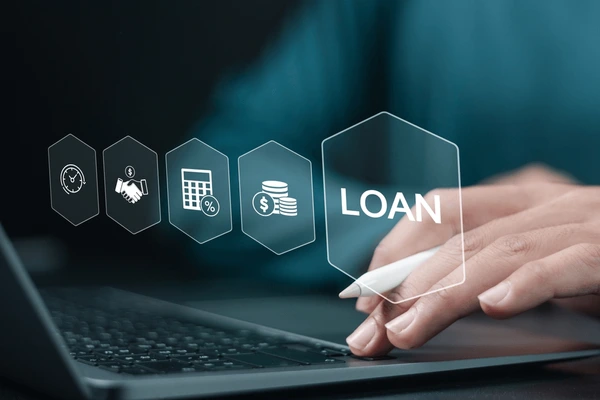
Know How to Get a Personal Loan Without ITR
November 2, 2025
Does a Student Loan Affect Your Credit Rating in Florida?
November 2, 2025How to Get Preapproved for a Home Loan in the United States
Understanding Home Loan Preapproval
Home loan preapproval is a critical step in the mortgage process for potential homebuyers. It is a more formal assessment than prequalification and involves the lender examining your financial status in detail. During preapproval, the lender will review your credit scores, income, debts, and other financial factors to determine how much money you can borrow. This process provides you with a letter of preapproval, which indicates the loan amount for which you are qualified and serves as a significant tool in your home-buying journey.
Preapproval differs from prequalification in that prequalification is generally a preliminary assessment based on information you provide without a hard credit check. Preapproval, on the other hand, entails a rigorous analysis of your financial situation and presents a clearer picture of your borrowing power. Knowing how to get preapproved for a home loan can save time and streamline the process for buyers in the competitive U.S. housing market.
There are multiple benefits to obtaining a preapproval. Firstly, it grants you a competitive edge when making offers in a market where homes may receive multiple bids. Sellers often prefer buyers who are preapproved as it shows serious intent and financial capabilities. Furthermore, understanding your loan amount helps to refine your home search, affording clarity on budget constraints and allowing you to focus on properties within your financial reach.
Additionally, a preapproval can expedite the home buying process. Since the lender has already completed a detailed review of your financial position, much of the groundwork is laid, meaning the actual closing process could be faster. Thus, knowing how to get preapproved for a home loan not only enhances your understanding of what you can afford but also empowers you to make informed decisions in a timely manner.
The Importance of Credit Score in Preapproval
Your credit score plays a vital role in the process of obtaining preapproval for a home loan in the United States. Lenders utilize this score as a key indicator of your creditworthiness, influencing their decision on whether to approve your application. Generally, a higher credit score increases your chances of securing favorable loan terms, including lower interest rates and reduced down payment requirements. To gain preapproval, it is essential to be aware of the minimum credit score requirements for various types of loans. For conventional loans, most lenders look for a credit score of at least 620, while government-backed loans, such as FHA loans, may accept scores as low as 580 with a 3.5% down payment.
Improving your credit score before applying for preapproval is an advisable strategy. Start by reviewing your credit report for any inaccuracies or discrepancies that may negatively impact your score. You are entitled to a free credit report annually from each of the major credit bureaus: Equifax, Experian, and TransUnion. If you identify any errors, promptly dispute them to have them corrected.
Additionally, managing your existing debts and making timely payments is crucial in elevating your credit score. Aim to reduce credit card balances to maintain a low credit utilization ratio, ideally below 30%. Establishing a history of responsible credit usage can help demonstrate reliability to lenders.
Furthermore, avoid applying for new credit in the months leading up to your home loan application, as this can result in hard inquiries that temporarily lower your score. By placing emphasis on your credit score and taking proactive steps to enhance it, you will significantly improve your chances of how to get preapproved for a home loan in United States, thereby paving the way for a successful home-buying experience.
Gathering Necessary Documentation
When seeking to understand how to get preapproved for a home loan in the United States, gathering the necessary documentation is a crucial first step. Lenders typically require several key documents to assess your financial situation, creditworthiness, and ability to repay the loan. These include income verification, tax returns, bank statements, and employment history.
Income verification is fundamental in demonstrating your earning capabilities. This can include recent pay stubs, proof of additional income sources, and, for self-employed individuals, profit and loss statements from your business. Lenders often look for consistent income, so providing at least two years’ worth of pay stubs and tax returns is advisable.
Your tax returns, usually for the last two years, offer lenders insight into your income stability and overall financial health. Be prepared to provide IRS Form 1040, including schedules for any additional income or deductions. This information can aid in assessing your debt-to-income ratio, which is pivotal in the preapproval process.
Bank statements serve as a reflection of your financial habits and liquidity. Lenders will review bank statements from the past few months to verify your savings and checking accounts’ balances. It’s helpful to ensure you have at least two months’ worth of statements to provide a comprehensive picture of your finances.
Lastly, your employment history will be scrutinized to confirm job stability, ideally demonstrating at least two years of continuous employment in the same field. If there have been gaps in employment, be ready to explain them concisely. By organizing these documents efficiently—ideally in a digital folder or binder—you can streamline the application process. This preparation will not only help you understand how to get preapproved for a home loan but also potentially enhance your chances of receiving favorable financing terms.
Finding the Right Lender
When considering how to get preapproved for a home loan in the United States, selecting the appropriate lender is a critical step in the process. Potential borrowers have various options, including traditional banks, credit unions, and online lenders, each with its unique advantages and disadvantages. Understanding these differences can aid in making an informed decision.
Traditional banks often provide a comprehensive range of services, including checking and savings accounts, mortgages, and personal loans. They are well-known institutions and thus instill a sense of reliability; however, their requirements for preapproval can be more stringent compared to other lenders. Additionally, traditional banks may have longer processing times, which can delay the home buying process.
Credit unions, on the other hand, can be an excellent alternative. They tend to offer lower interest rates and fees because they are not-for-profit institutions. Furthermore, credit unions generally have a more personalized approach to lending, as they serve specific communities or groups. However, one potential downside is that membership may be limited based on certain criteria, such as geographical location or professional affiliation.
Online lenders offer a convenient method for obtaining a home loan, often streamlining the preapproval process with user-friendly applications and faster responses. They may provide competitive rates due to reduced overhead costs. However, borrowers should exercise caution as some online lenders may lack the same level of customer service and transparency found at more traditional institutions.
Regardless of the type of lender chosen, conducting thorough research is paramount. Reading reviews, comparing rates, and consulting with trusted individuals can offer valuable insights. Understanding how to get preapproved for a home loan is greatly influenced by the lender’s policies and practices, making an informed choice essential for success in the home buying journey.
Submitting Your Preapproval Application
Submitting an application for preapproval is a crucial step in the home-buying process. Knowing how to get preapproved for a home loan ensures you are prepared and can move forward with your real estate plans effectively. There are several methods available for submitting your application: online, in-person, or via phone.
For online applications, lenders typically have a user-friendly portal where you can fill out your details. This method is often preferred due to its convenience, allowing you to complete the process at your own pace. Most online lenders will require you to provide information regarding your income, employment history, assets, and debts. It is essential to have these documents ready, such as W-2 statements, pay stubs, and bank statements, to facilitate a smooth application process.
Alternatively, you can submit your application in person at a local branch of your chosen lender. Meeting with a loan officer provides the benefit of face-to-face interaction, allowing you to ask questions and clarify any uncertainties during the process. The officer will guide you through each step, explaining what information is required and how it impacts your preapproval status. This method can also be helpful if you prefer to discuss your financial situation directly.
Lastly, applying via phone can be suitable for those who may not have access to the internet or wish to avoid online forms. In this case, a representative will interview you over the phone, asking for the same pertinent information as in the other methods. Regardless of the method chosen, be prepared for potential questions from the lender, which may include inquiries about your employment stability and overall financial health. Understanding how to get preapproved for a home loan can significantly smooth your path towards homeownership.
Understanding the Preapproval Letter
A preapproval letter is an essential document in the home buying process, particularly in the United States. It indicates that a lender has assessed a borrower’s financial situation and is willing to extend a loan up to a specified amount, contingent upon certain conditions. This letter provides prospective homebuyers with a clearer understanding of their budget and reinforces their buying power when making offers on properties.
The preapproval letter typically contains key information, including the borrower’s name, the loan amount that the lender is willing to offer, the type of loan (such as fixed-rate or adjustable-rate), and the conditions that must be met for the loan approval to become finalized. This documentation also reflects the lender’s validation process, which includes a credit check, income verification, and assessment of financial assets.
It is important for homebuyers to be aware of the validity period of the preapproval letter. Generally, these letters remain valid for anywhere from 60 to 90 days, depending on the lender’s policies. This timeframe is crucial for buyers to understand, as they need to act within this period to leverage their preapproval effectively. If the preapproval expires, borrowers will need to reapply and potentially face fluctuations in interest rates or changes in their financial situation.
Furthermore, receiving a preapproval letter can give buyers a competitive edge in the real estate market. Sellers often prefer to negotiate with buyers who have a preapproval, as it indicates financial reliability and readiness to proceed with the purchase. In this sense, understanding how to get preapproved for a home loan is a pivotal step for anyone looking to successfully navigate the housing market in the United States.
Common Mistakes to Avoid
When considering how to get preapproved for a home loan in the United States, it is crucial to be mindful of common mistakes that can jeopardize the loan process. One significant error is changing jobs. Lenders need to see a stable income during the preapproval phase, and switching employers can raise red flags. If a job change is necessary, it is advisable to wait until after securing the loan approval to make any transitions.
Another prevalent mistake is making large purchases during the preapproval period. Obtaining a new car or financing furniture can alter your debt-to-income ratio, which lenders evaluate when deciding on loan approvals. It is essential to refrain from substantial financial commitments until the mortgage is finalized to avoid complications.
Additionally, closing credit accounts can adversely affect your credit score. Many individuals mistakenly believe that doing so will improve their standing, but it can actually reduce available credit and length of credit history—important factors in credit scoring. Instead, maintain existing accounts and continue making timely payments, as this builds a more favorable credit history.
Lastly, it is advisable to avoid taking on new debt. Opening new credit cards or loans can increase your overall debt burden, leading lenders to question your financial reliability. Keep your finances stable and refrain from any major changes in spending or borrowing habits between preapproval and closing on a home.
By being aware of these common pitfalls, potential home buyers can navigate the preapproval process more effectively. Understanding how to get preapproved for a home loan requires diligence and caution to ensure that financial stability is maintained until the loan is secured.
What Happens After Preapproval?
Once you have successfully navigated the process of how to get preapproved for a home loan in the United States, the subsequent steps are critical in ensuring that your home buying journey proceeds smoothly. The first major step after receiving preapproval is house hunting. With your preapproval letter in hand, you will have a clear budget, which allows you to explore homes that meet both your financial capabilities and personal preferences.
During your search, it is essential to stay within the limits set by your preapproval amount. Keep in mind that the preapproval specifies the maximum amount you can borrow, but your monthly housing budget may be lower due to other expenses. Thus, it is prudent to assess your personal financial situation, including potential expenses such as property taxes, homeowners’ insurance, and maintenance costs.
Once you find a property that appeals to you, the next step involves making an offer. With your preapproval, your offer is strengthened, signaling to sellers that you are a serious and financially capable buyer. It is also important to be aware of the market dynamics; being preapproved can give you a competitive edge in a crowded market, but negotiating terms that suit you will remain crucial.
Following a successful offer, you will enter the final mortgage approval stage. This process is necessary to validate your financial status and the property you wish to purchase. The lender will conduct a thorough review of your financial documents and may require updated information if there has been any significant change in your circumstances since the initial preapproval. It’s also essential to avoid any significant financial changes during this stage to prevent complications.
In summary, understanding what happens after obtaining preapproval will help ease the home buying process. Stay informed and proactive throughout the stages, from house hunting to final mortgage approval, to ensure a smooth transaction. Being preapproved not only provides clarity and confidence but also enhances your purchasing power as you navigate the housing market.
Conclusion and Final Tips
In conclusion, understanding how to get preapproved for a home loan in the United States is an essential first step in the home buying journey. Preapproval equips potential homebuyers with the necessary information about their borrowing capacity and establishes a serious intent to purchase. By reviewing various lenders, considering interest rates, and preparing your financial documents, you can streamline the preapproval process effectively.
To ensure a successful preapproval application, it is advisable to keep the following checklist in mind:
- Check your credit score: A higher credit score can lead to better interest rates. Address any discrepancies before applying.
- Gather essential documentation: Prepare W-2s, bank statements, and proof of income to provide a comprehensive overview of your financial situation.
- Limit new debts: Avoid taking on additional loans or credit lines before and during the preapproval process. This helps keep your debt-to-income ratio in check.
- Stick to the budget: Know how much you can afford by calculating household expenses, and do not exceed this limit to maintain a healthy financial standing.
Moreover, it is wise to maintain good financial practices throughout the home buying journey. Regularly review your expenses, avoid unnecessary purchases, and keep savings in a dedicated home buying fund. Always stay informed about market conditions and potential changes in interest rates, which can influence your preapproval. Being proactive can safeguard your financial position and enhance your chances of securing favorable loan terms.
By adhering to these guidelines and strategies on how to get preapproved for a home loan, prospective buyers can navigate the journey with confidence and clarity.
Here’s a clear, no-nonsense FAQ on getting preapproved for a home loan in the U.S.
1) What is a mortgage preapproval?
A lender reviews your finances (income, assets, debts, credit) and issues a letter stating how much you’re likely able to borrow—useful when making offers. It’s not a final loan approval.
2) How is preapproval different from prequalification?
Prequalification is a quick estimate, often based on self-reported info; preapproval verifies documents and credit, so it carries more weight with sellers.
3) Why get preapproved before house-hunting?
You learn your price range, spot issues early, and strengthen your offer with a credible letter. (Sellers and agents expect it in many markets.)
4) How long does a preapproval last?
Typically 60–90 days (some lenders as short as 30). If it expires, update docs and credit to refresh it.
5) What documents will lenders ask for?
Commonly: last 30 days of pay stubs, W-2s and tax returns (2 years), recent bank/asset statements, ID, and proof of down-payment funds (gift letter if applicable). Self-employed borrowers often add business returns, a YTD P&L, and a balance sheet.
6) Does preapproval require a hard credit check? Will rate-shopping hurt my score?
Yes—preapproval is a hard inquiry. But multiple mortgage inquiries within a 45-day window count as one for scoring, so shop around.
7) How do lenders decide my maximum loan?
They look at your debt-to-income (DTI) ratio, credit profile, income stability, assets/reserves, and the loan program. For conventional loans run through Fannie Mae’s automated system, DTIs up to 50% can be permitted in some cases.
8) How much down payment do I need?
It depends on the loan type and your profile. Examples: FHA often allows 3.5% down; VA and USDA programs can allow 0% down for eligible borrowers and properties. Conventional loans can be as low as 3% down for some programs. (Check lender criteria.)
9) Can I get preapproved if I’m self-employed or on 1099 income?
Yes—expect to document two years of personal/business tax returns, plus a YTD P&L and balance sheet; lenders assess stability and trends.
10) Does a preapproval guarantee I’ll get the mortgage?
No. Final approval depends on full underwriting, the property appraisal/title, and your finances remaining consistent until closing.
11) Can I get preapproved by multiple lenders?
Yes—and it’s smart to compare. Keep inquiries within 45 days to minimize credit impact.
12) When should I get preapproved?
A few weeks before serious house-hunting is typical; sooner if you expect income/credit complexities, since gathering docs can take time.
13) What if my situation changes after preapproval (new debt, job change, big purchase)?
Tell your lender immediately—big changes can reduce or void your preapproval.
14) Will I get a Loan Estimate at preapproval?
Lenders can’t require documents just to issue a Loan Estimate (you only need to provide six key application items), but they’ll still need docs to truly preapprove you.
15) Is a rate lock part of preapproval?
Usually not. A rate lock is a separate agreement that fixes your interest rate for a set period (often 30–60 days or more) once you’re further along. Check your Loan Estimate to see if/when your rate is locked.
Quick steps to get preapproved
-
Pull your own credit and fix errors.
-
Gather core docs (pay stubs, W-2s/returns, bank/retirement statements, ID, down-payment source).
-
Apply with 3–4 lenders (same 45-day window).
-
Review each Loan Estimate (rate, APR, fees, mortgage insurance).
-
Keep finances steady until closing (no new debt; avoid large, unexplained deposits).
If you want, tell me your rough income, debts, and down-payment plan—I can estimate an affordable price range and prep a personalized doc checklist.
Read More:
- Comparing LendingClub and easzfin: Which Lending Platform is Right for You?
- How to Get a Startup Business Loan with No Money in Hawaii: A Step-by-Step Guide
- Comparing Credibly and EasyFin: Choosing the Best Loan Provider for Your Needs
- Top 10 Trusted Loan Providers in Massachusetts for Competitive Rates
- How to Secure a Food Truck Loan: A Step-by-Step Guide to Financing Your Mobile Business




